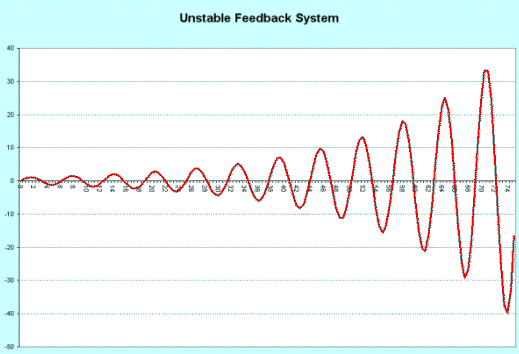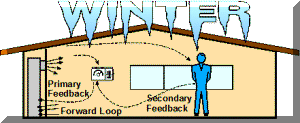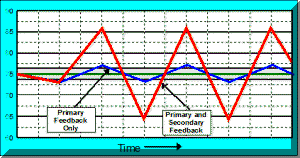Feedback Systems & Scheduling
A Few Basics
Most scheduling and inventory control systems, are "feedback systems," i.e. they sense the current state of the system, compare it to a desired state and initiate action to correct discrepancies. Feedback systems are also known as "cybernetic systems".
Feedback System Example
Feedback systems are common in everyday life as illustrated by the home heating system. Here, the controlled variable is "Room Temperature." The system is designed to maintain the desired temperature as indicated by the "Set Point" on the thermostat.
The "forward loop" consists of the furnace and the room air. The thermostat and signal wires constitute the "feedback loop." In this case it is the primary feedback loop.
When the furnace receives a signal for heat from the thermostat the burner ignites. When the heat exchanger warms, the fan circulate hot air into the room and room temperature rises. When the thermostat senses that room air has reached the set-point, it signals the furnace to turn off and the burners shut down. The circulation fan continues until the heat exchanger cools.

The blue line in the figure 2 shows the resulting temperature over time. It varies between 74 and 76 degrees.
Deadband--the thermostat starts or stops the furnace only when the difference between set-point and room temperature is greater than about 1.0 degree. Without this deadband, the furnace would cycle every few seconds with the minute temperature changes. The deadband produces small temperature variance.
Time Delay--there is a time delay while the heat exchanger heats or cools and this causes a further variation in room temperature. While the heat exchanger is warming, the room temperature continues to fall; when the heat exchanger is cooling it continues to heat the room even after the thermostat calls for shutdown.
This illustrates two reasons why feedback systems become unstable: time delays and non-linearity.
Non-linearity refers to a response that is not proportional to input. The dead-band is non linear. A small temperature change brings no response from the thermostat. A slightly larger change starts the burner at full heat. The burner is either on or off and is also non-linear. A burner that could modulate and produce heat in proportion to the temperature difference between set-point and room temperature would be more linear and, thus, more stable.
In this heating system, operating on its own, the time delays and non-linearity produce only small oscillations and system instability is small. At times, an additional feedback loop is introduced into a formerly stable heating system. This takes the form of a thermostat fiddler-- people who attempt to improve on the control system by changing the set-point frequently.
The red line in figure 2 shows the result. When the fiddler detects a slight decrease in temperature, he/she raises the set-point to a very high setting, say 85 degrees. The thermostat responds, the burner ignites and room temperature rises. Fiddlers rarely notice the rising temperature until it reaches, say 80 degrees. They then respond by excessively lowering the of set-point while cursing the defective furnace.
This illustrates amplification in the feedback loop. The temperature difference is amplified disproportionately and over-correction results. The thermostat fiddler also adds complexity and additional non-linearity.
Amplification is common when humans are part of a control system. With scheduling and inventory systems, it results in excessively large batches of product and excessively large inventory alternating with shortages.
Our heating system example illustrates several fundamental causes of instability and chaos:
Non-Linearity
Amplification
Time Delays
These factors can produce instability and chaos when present in any part of the system. However, feedback loops are especially sensitive.
In some feedback systems amplification continues with each cycle resulting in larger and larger excursions. The figures illustrate. In theory, the system oscillates to infinity. In reality, some physical constraint limits the excursions.
 For example, inventory and shortages may alternate getting larger and larger until the
warehouse is full and there is no room for additional
inventory. The company may run out of cash
to pay for the inventory and thus force limitation. There is lots of inventory but never the
right inventory.
For example, inventory and shortages may alternate getting larger and larger until the
warehouse is full and there is no room for additional
inventory. The company may run out of cash
to pay for the inventory and thus force limitation. There is lots of inventory but never the
right inventory.
Instability results primarily from amplification and time delays. Time delays in the feedback loop have larger effects than in the forward loop but any unnecessary amplification can contribute to instability. These affects are common in everyday life. Most of us have heard the awful squeal that sometimes affects public address systems. In such a situation, the speakers voice enters a microphone. An amplifier increases the signal and sends it out via loudspeakers. When the signal from the loudspeakers reenters the microphone it is amplified a second time, a third time and so on. The signal increases until the limits of the amplifier or speaker have been exceeded.

Instability In A Feedback System
Most of us have heard the results of an unstable feedback system in the form of a Public Address system with too much amplification.

Sound Level Output
Here we see the output of the system in sound level.
■ ■ ■ ■ ■ ■ ■





